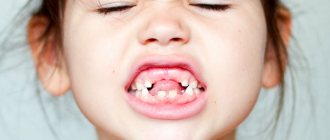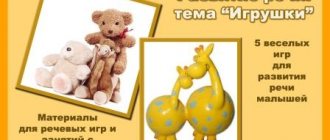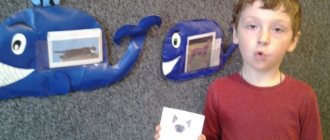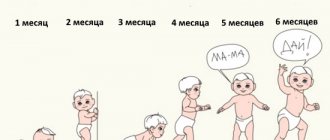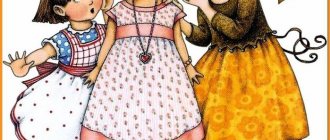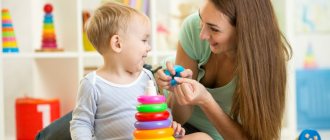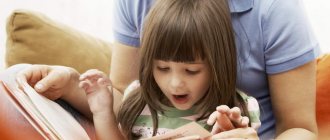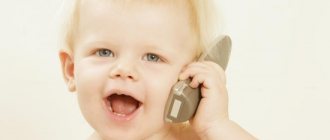Pediatricians have proven that the child’s neural network responsible for speech is associated with fine motor skills of the fingers. Therefore, any active work: modeling, fiddling with small parts on a string, finger painting will contribute to the development of the speech apparatus.
Based on this knowledge, experts have developed special toys, games with which not only develop mental abilities, but also stimulate desire and the ability to speak. They will be especially useful for children with delayed speech development. And to get the greatest effect and benefit, keep in mind that each age has its own interesting games. Therefore, toys for children’s speech development can be roughly divided by age.
The best educational toys for children from 1 to 2 years old
At this age, interaction between parents and their child is important. It is advisable to voice and play out every action of the child, comment on his desires, expectations, actions. Simple rhymes and songs will help with this. Finger games, gestures, and figures are also relevant for babies under 2 years old. You can hide various objects and invite your son or daughter to name or show with the help of gestures and facial expressions what exactly is hidden. Another 1-2 years will help with early development:
- Lace-up beads. It consists of small figures with holes and a flexible, not too thin cord. Lacing is good for developing finger mobility and coordination - invite your son or daughter to string the figures on a string and then move them. To develop the language of communication, you can invite your child to make up his own story and string together toys as events unfold. By picking up animal figurines, the baby may try to imitate animal sounds. Encourage him with questions: “Who is this?”, “What does he do?”, “What sounds does he make?”
- Ball. It can be of different sizes, shapes, colors. Throw the ball into your baby's hands and let him try to catch it. This action will help not only develop sensory sensations with your fingers, but also refinement of movements. From 1.5 years old, you can learn to pronounce sounds automatically: for example, toss a ball - pronounce the first sound, then the second, etc. In the future, you can develop syllabic perception of words: toss the ball - pronounce the first syllable, the second time - another one. Using two balls of different colors, you can teach your baby about vowels and consonants. For example, if you caught a red ball, you pronounced a vowel sound, and a blue ball, a consonant sound. But don't repeat yourself! For children at 1 year old, the time for lexical and grammatical games begins. For example, a mother calls the word “night,” and their child must catch the ball and name the associated paired word “day.”
At 2 years old, a child’s curiosity about the world around him begins to develop - an excellent opportunity to combine educational games with speech development. You can read more about toys for newborns in our article.
Educational toys to improve a child's motor skills
All loving parents try to do everything to ensure that their children receive comprehensive development from a very early age. Already from the cradle you can teach your baby precise movements. To do this, rattles are hung above the crib. The child reaches out to them, grabs them, and over time begins to hold and choose the figurine that he likes best.
For older children from one to three years old, use various educational toys to improve motor skills of their hands and fingers.
- beads of different sizes , just make sure that the thread is strong and does not break. Let the baby move the beads from side to side
- Books and lacing toys are used for children starting from 10-11 months. Thanks to such activities, your child develops not only fine motor skills, but also his eye. This action will be useful in the future at school. It will be easier for the child to learn to write and draw
- Finger labyrinths also develop precision of movement, perseverance and patience in the baby.
- Construction sets , pyramids - there are a lot of such products in stores, you can buy them for every taste, color, age. These toys help improve spatial thinking. Experienced parents advise buying construction toys made of wood. Products made from such material carry a positive charge and are pleasant to the touch.
- Mosaics and puzzles are also important for the accuracy of movements; in addition, by collecting a picture, the child learns to think logically and trains attention
IMPORTANT: When choosing toys for kids, pay attention to the quality so that the paint does not wear off or smell. After all, children can involuntarily pull them into their mouths. Let the seller show a certificate of their quality.
Toys for children from 2 to 3 years old
At this age, preparation for preschool begins. In kindergarten, children actively communicate, share experiences and play. Therefore, the task of adults is to maximize the communication abilities of the baby by this time. Suitable for this:
- Soft toy. With her, the baby can learn to communicate, express his grievances or seek reconciliation. Psychologists say that with the help of such a game, a child will get rid of stress, hone his teamwork skills, and learn to formulate his thoughts. Watch your child, in many ways he will repeat with his plush “friend” the situations that he has already had in life with his parents. Therefore, watching your child play, you can look at your relationship with the baby from the outside. Many toys contain a special filler - granules for the development of tactile perception of fingers.
- Pyramid. This is a didactic toy for the development of speech and correct movements. Learn the colors with your child, and then say their first syllables when placing the corresponding ring on the base stick. Another activity option is to break words into syllables and name them in the order in which the rings are installed.
- Clothespins. You can use them in different ways, for example, prepare a hedgehog figurine from cardboard and ask your child to attach clothespins and needles to it, saying: “How does a hedgehog do it?” The baby clearly says in response: “Fir-fir-fir.” A more useful alternative is a busy board. Functional objects located on the board can be grabbed, twisted, opened, while also pronouncing words.
From the age of 3, children go to preschool, so educational toys become more multifunctional.
Attentive child: what toys will help a child develop concentration and attention?
- In the first years, your beloved child is not yet able to control his concentration perfectly. A child may want to hold one toy in his hands right now, and another in ten seconds. He can be distracted from his studies by any sound or advertising on television.
- Concentration develops gradually. Moreover, the process occurs differently for all children. In the majority: children can become quite attentive already at school age. Although this is not always the case, there are exceptions - hyperactive children
- To make your baby attentive, use educational toys that may interest him. When the child finally gets a little tired of the perpetual motion, sits down to rest, take funny pictures or cubes , play with him. Ask to name who is drawn on them. Take a doll , ask what color her outfit, shoes, hair are.
- For older children, ask them to guess which of the toys in the room matches your description. Or play a guessing game. To do this, have the child look carefully at the pyramid of cubes and turn away. You will rearrange the cubes. Let him guess what has changed
IMPORTANT: Do not restrain your baby if he does not want to engage in educational games at this moment. Choose a time when he is predisposed for such activities.
For children from 3 to 4 years old
The main task of teachers and parents at this age is the child’s adaptation in kindergarten. Kids who spent a lot of time with their parents and relatives begin to get used to the new team. Developmental speech therapy games will help them with this:
- Busy boards based on fairy tales. An interesting game that develops imagination, speech, teaches young viewers to empathize with the characters of the performance and even acting skills. At first, the parents themselves show the performance, explaining to their child how to open the windows and what to do. During the performance, you can ask your viewer: “What does this cow do?” or “How sad is the top?”, etc. Then the child himself will want to try to “play out” some scene with the help of heroes hidden behind the “windows”. By opening windows, locks, lacing the “ladder”, he will develop the flexibility of his fingers, movements, and by pronouncing the characters’ lines – his speech apparatus.
- Magic box with surprises. Toys for 3-year-olds must include objects for imagination and tactile perception. Invite your child’s friends over and invite them to take turns taking small figures, safe embossed objects, etc. out of the “magic box.” Children will be happy to touch an unknown object and guess what it is. Ask the company to talk about what they pulled out: “What does this item do?”, “What color is it?” etc.
- Musical instruments. Children 3-4 years old are interested in trying to reproduce sounds themselves using musical instruments. Percussion is especially useful - it develops meaningful movements and interaction between both hemispheres. The child learns to hold the stick more confidently and remembers different tones of sounds. Using xylophones/metallophones you can sing words and rhymes. And this contributes to rapid “pronunciation” and beautiful speech without errors.
At 4 years old, the child continues to study in the middle group of kindergarten, he has already adapted to the team, and it’s time to prepare for school.
Toys to stimulate speech development
Good afternoon, dear participants! My name is Ershova Evgenia. I am a speech therapist, a specialist in the speech and intellectual development of children and issues of children's multilingualism. Author of shillopop.com
The development of a child’s speech is an important and complex process. Most parents sooner or later ask questions: from “we don’t pronounce R” to “we don’t say it at all.” Despite the fact that we recognize the individual development path of each child, there are norms of speech development, stages and patterns. Before I start talking about toys for language development, let me make a few important points.
The development of a child is individual and depends on many factors, but it is subject to certain norms and goes through its own stages.
Speech development occurs through communication with people, primarily with parents.
Speech development occurs in two directions: speaking and understanding.
- 3-6 months : attention to the face, facial expressions of an adult, imitation of movements, repetition of sounds more like vowels, “singing”, humming in response to an adult’s speech.
- 6-9 months : babbling - pronouncing sounds similar to consonants, repeating syllables, responding to their name, understanding words, phrases related to everyday life.
- 9-12 months : imitation of chains of syllables, imitation of coughing, clicking, recognizing objects by name, following simple instructions
- 1 year : appearance of the first words, active use of gestures for communication, increase in passive vocabulary, understanding of speech.
The first words are not necessarily the long-awaited ones of mom or dad. The first words are often associated with actions: na, am, give. Toddlers begin to talk about what they want, see and feel, rather than what they know or think. Therefore, the first words usually denote the most important and interesting objects, objects and actions for the baby:
- people surrounding the child (mother, father, grandmother, grandfather, uncle, aunt);
- actions performed by the baby or other people (knock - knock, top - top, am - am);
- animals and birds (meow, ki, kitty; av - av, ava; mu; igo - go, ko - k o; kar - kar)
- food (ako - milk, ana - banana, adya - water, tai - tea);
- parts of the face and body (nose, mouth, eyes);
- baby’s toys and things in the house (bear, ball, pacifier, ale - telephone);
- clothes and shoes (socks, pants, hat);
- transport (bi - bi - car, y - y - plane);
- words that reflect human states and certain qualities (I want, oh, ah, bo - bo).
Most first words are sound complexes consisting of one or two, often identical syllables (“mu”, “meow”, “av-av”, “pi-pi”, “da-da”). Experts call such sound complexes “the language of nannies” or “the language of babies.”
Often the first words of babies are difficult to recognize, so many parents, when talking about their child, say that he speaks “his own language.” Some babies pronounce only the first or stressed syllable of a word. For example, the word “drink” is transformed into “pi”, and “milk” into “ako”. Other children “change” words beyond recognition.
The word transformed by the child can have the same number of syllables as the original and retain the location of the stress. But at the same time, it is absolutely not similar to the original word, for example: “nanAna” - “medicine”; "tititI" - "bricks".
Most often, children distort words with confluences of sounds in which two or more consonant sounds follow one after another, for example, as in the word “hello,” which the child pronounces as “dyatite.”
In words that are “difficult” in sound composition, the child swaps sounds and syllables, skips syllables, shortening words.
1.5-3 years : increase in active vocabulary to 25-90 words, the number of words is an individual indicator, the child’s language abilities are constantly improving in communication with people around him, words act as sentences: the ball “get the ball”, “meow” the cat is coming, the phrase gradually appears.
By 3 years:
the child’s vocabulary reaches approximately a thousand words, the baby speaks not only about objects, current phenomena and events that he observes, but also about what is not directly in front of his eyes, children recognize and name pictures in books, more complex ones appear in their speech sentences consisting of two or more simple sentences “I think I’ll eat”, “look, it’s a cat.” Children with well-developed speech begin to speak in complex sentences: “when I’m big, I’ll lift you up.” The baby begins to learn the grammatical rules of the language. Speech develops qualitatively and quantitatively.
Speech development occurs along with general development (mental and physical).
It is customary to distinguish the following stages of development and leading activities of each age (up to 7 years):
- Infancy (emotional communication)
- Early age (subject activity)
- Preschool age (play activities)
Taking into account the leading activity, it is possible to build a harmonious plan for the child’s development.
The main period of speech development falls during the period of play activity.
Accordingly, classes will be more effective if conducted in a playful way . Often it is not even necessary to come up with an activity in the form of a game, since, in fact, any game has educational functions.
Many children are delayed in passing through such periods in speech development, cannot begin to speak for a long time, and experience difficulties in pronouncing individual sounds. In such situations, it can be difficult for parents to understand how much their child needs the help of specialists.
Information on age norms and characteristics of children’s speech development was prepared based on materials from books that I recommend that all parents read:
- Davidovich L.R. Reznichenko T.S. Does your child speak poorly? Why? What to do?
- Gribova O.E. What to do if your child doesn't speak?
- Koltsova M.M. The child learns to speak.
- Yanushko E.A. Help your baby talk!
If you are really concerned about a question about your child’s speech development, it is better to ask it to a specialist, a speech therapist. This is too serious a topic to be entrusted to a forum or friends on the site. They will most likely begin to calm you down, and this is the most dangerous path; you can lose precious time. Now you can get professional advice without even leaving your home, via Skype. The speech therapist will reassure you or confirm your fears, but in any case, you will no longer have guesses, but facts and an action plan.
More and more parents trust this method. My online speech therapy office has been operating for three years now. I asked my clients to write reviews about Skype consultations. If you are unsure whether this method is right for you, read on to decide. Or go to the clinic, the nearest development center, speech therapy kindergarten.
Now, let's look into the “chest” of toys! Toy stores are my favorite. Whenever possible, I look into such stores, especially on vacation. You can bring unique things from different countries. Toys are simply necessary for activities with children. I don’t buy everything, but choose very carefully. Some of the toys in my collection may seem strange, but each has its own purpose. Over the years of work, several favorites have emerged, and I will show them to you today. I hope that my story will help you navigate the variety of toys, push you to the right decision and save you from unnecessary expenses. Many toys can be made with your own hands, I will also tell you about this, and if you want more information, then welcome to the site for ideas, patterns or ready-made toys.
Ball.
You can perform a huge number of exercises by throwing or rolling a ball. This technique is especially good for mobile children who find it difficult to sit still. We repeat sounds, syllables, words, answer questions and everything in the game! For safety, I choose soft balls made of different materials, with different fillings, so that the game gives different sensory sensations and develops tactility.
Examples of games:
- Invite your child, when he hears “A,” to throw the ball up, and when he catches the ball, repeat this sound.
- Mom throws balls of different colors to the child. The baby catches it and names a vowel sound if the ball is red, a consonant sound if the ball is blue, and throws the ball back to mom
- The mother says to the child - I will say the first part of the word, and you will say the second: sa - har, sa - ni. The mother throws the ball to the child and says the first syllable, the baby catches it and throws it back, saying the whole word.
- The mother throws the ball to the child, calling out the sound for which the baby must name the word.
- The mother throws the ball to the child and calls a word, for example, day, and he must throw the ball back and call him the opposite - night.
Magic bag or box with a surprise
.
They turn any activity into magic! It’s so exciting to stick your hand into the unknown, guess what it is, and then you can discuss it. If you need to attract your child's attention to an object, hide it in a magic bag.
Game example:
Take an opaque bag, put objects on the topic being studied into it (geometric shapes, figures of animals, vegetables or fruits, sensory elements, etc.) and invite the child to find a ball, cube, giraffe, elephant, etc. by touch.
Tube.
You can find a similar toy in different versions in the store: wooden, as in the photo, plastic, or you can make it yourself from paper, felt or porous rubber.
The master class that you received in the newsletter will help you make a toy yourself. This toy perfectly develops correct exhalation, teaches you to control your breathing, and forms a strong, directed air stream, which is important both for speech in general and for complex sounds: S, Z, Sh, Zh, R.
Game example:
Invite your child to blow into the tube, and at this time you count how long the ball will stay in the air. Gradually, the duration of exhalation will increase, and the baby will feel like a champion.
Spinning top.
I remember being fascinated by this toy as a child. My little students are also partial to it, but launching a top on their own is not an easy task. What a useful skill this is: developing fine motor skills, visual coordination, dexterity, and strength of the leading fingers. You, of course, have seen a traditional top, maybe even made it yourself from a match and cardboard, so pay attention to my most unusual find (on the left in the photo): a top that not only spins, but also stands on a leg if launched correctly .
Game example:
It is interesting for mother and child to spin the top at the same time, noticing whose spins longer and more beautifully. Have a mini competition!
Tweezers, sticks.
This is not quite a toy, more of a tool, but owning it also has a positive effect on fine motor skills, stimulating the development of speech. Such chopsticks for children in Asia are sold in supermarkets, pharmacies, and hardware stores. And if you think about it, this skill is quite difficult for many adults, let alone 2-3 year olds. However, it is possible! And it is at an early age that this skill develops speech and intelligence. Take a closer look at the packaging, it says so there :)
Jokes aside, I was delighted to discover these sticks, and now I bring them from every trip as a gift to my children. Now you know what to ask your friends who are traveling to Asia. You can not only eat them, but also play with them.
Example games:
- In the children's kitchen you can prepare not only traditional soup and porridge, but also rolls or sushi, and then have lunch and eat with chopsticks.
- Games with sorting through different cereals will become more interesting and difficult if you arrange the cereals not with your fingers, but with tweezers or chopsticks. Mix beans, peas and pasta, invite your child to put them on different saucers.
- Place cotton balls of different colors in a bowl and ask your child to sort them by color - this task is easier than with cereal, so it’s a better place to start.
Clothespins.
Again, not so much toys as household items. But you remember that by the age of 3, a child masters object-based activities and it is real objects that are the most interesting for him. And, as you and I can see, they are also useful. Activities with clothespins can be practical in nature, the way we usually use them: hanging laundry, notes, pictures. But you can also add games to these activities. And then the clothespins are no longer clothespins, but birds, cars, etc. Or parts of toys, like in this photo.
Examples of games:
- The mother shows the child the hedgehog and says: “Look what kind of hedgehog came to visit us. He lost all his needles along the way. Let's help him and give him needles. Now let’s snort like hedgehogs.” But a cloud flew in (mom takes out a prepared cloud) and it began to rain. Let's make it rain on the cloud. How does it drip? (the child says like rain is dripping: drip-drip drip-drip)"
- Equipment: cards with syllables, words; clothespins red, green, blue. Exercise. The child is asked to choose a card with a syllable and match the color of the clothespin with the sound on the card. The child must clearly pronounce the sound and name the color of the clothespin he has chosen. For example: the syllable ba: the sound [b] is a hard consonant, so the clothespin is blue; The sound [a] is a vowel, so the clothespin is red.
- If the child can already read and knows what stress is, then you can use clothespins in the game with word cards. The mother shows the child a card with the word and asks to put the emphasis using a clothespin.
- Or the mother herself puts emphasis on a word that can have several meanings and invites the child to explain what the word castle means and what castle means.
Sounding objects
(development of phonetic hearing).
The first thing that is recommended to be checked when a child has a speech delay is hearing. And if everything is fine with hearing, then the main task is phonetic development. We distinguish between speech sounds and non-speech sounds. We need sounding toys for the development of non-speech hearing.
You can make them yourself from Kinder Surprise containers or small yogurt bottles. We fill paired containers with objects that can be distinguished by ear and play. You can use ready-made wooden toys - sounding balls from Wald.
Example games
:
- determine by sound what is inside - the child takes the container and determines by ear what it sounds like: a bell, coins, cereal, etc. Another version of this game is when you jingle something behind a screen and the child guesses
- find a pair - we lay out containers in front of the child, two with the same filling, and ask them to choose a pair for each.
- What is extra - we lay out 3-4 containers with the same filling and one with a different one, the child goes through everything and listens to the sounds, and then decides which one is extra.
I also really like the sounding balls from Wald.
Bibabo or hand toys.
Faithful companions of any speech therapist, not every child will agree to talk to an unfamiliar aunt during a consultation, but they will be happy to share their secrets with a “living” bear. Knowing this childhood weakness, I collect such helper toys. Everyone loves to cuddle and hug the bear, feed it, stroke it - it copes well with the situation of getting to know each other and establishing contact.
The cheerful little frog opens his mouth wide and croaks, of course.
The owl teaches you to accurately pronounce the important and complex sound U. The prankish pig grimaces, talks a lot and jokes constantly. The horse can click, and this helps us quickly learn to pronounce RRR. Here are just a few ideas on how the bibabo toy helps with speech development.
Example games:
- Place the toy on your hand and change your voice slightly to make it seem like the toy is speaking, not you! Act out a scene of getting to know each other, offer to play together.
- A glove toy can become the leader of your homework and teach your child new things. A wise owl flies from the forest specifically to teach counting, and the bear draws with the baby.
Finger Theater.
It will be useful throughout early and preschool age. First, he teaches to listen and observe, then develops fine motor skills when the child tries to put on or take off toys, and one day the child will speak in the words of his favorite character. It’s worth talking about the finger theater separately, because... the topic is inexhaustible, you can come up with an endless number of plots and characters! I'll show you several types that differ in how you manipulate them.
Traditional finger theater.
Walking finger theater.
Another type of walking toys
Game example:
Role-play a well-known fairy tale, putting on and taking off toys, moving them according to the plot of the fairy tale, you develop finger dexterity and fine motor skills of the child. Most games with finger toys are theatrical games based on fairy tales or finger games with poems.
In fact, the list of toys goes on! It all depends on the specific situation. Some people need all these toys and even more, while others don’t even need that many, because... speech is already developing beautifully. Trust your parental intuition and the opinion of a specialist about your child, and then success in speech development is guaranteed to you.
Happy creativity and fun games!
Evgenia Ershova
author of the site "Shillopop.com"
PS This article is copyrighted and is entirely intended exclusively for private use; publication and use of it on other sites or forums is possible only with the written consent of the author. Use for commercial purposes is strictly prohibited. All rights reserved. Online school “Learning by playing”
You might be interested in:
Forward to the New Year. Animal friends
Halloween quest “Missing Words”
Thematic set of educational games “Seasons”
Toys for children over 4 years old
At this age, children begin to gradually become familiar with the alphabet, and games for preschool age become more and more diverse:
- Cubes, busy boards, sorters. They depict letters and objects whose names begin with them. For example, “N” – “threads”, etc. In such games, the help of adults is important. Voice letters and words so that kids hear and remember the correct pronunciation. Talk with your child. It is also important to encourage the baby to find a specific letter. The listed toys are more effective than educational books, because... in this case, motor skills develop better (the child spins cubes, opens windows on busy boards, etc.) and there is no purely teaching moment. After all, learning and playing at the same time is much more interesting.
- Designers. They are useful for preschoolers because they develop the speech-thinking centers of the brain. The kid examines the details, sorts them, looks for matches, collects something new, guided only by his imagination. To enhance the impact on the speech apparatus, invite your child to say out loud his actions, thoughts, voice what he is doing and what happened as a result. As a toy that develops speech, for 4-year-old boys you can consider a construction toy car, and for girls - doll houses.
- Cube with dots. An interesting activity for children 5 years old. Invite your child to roll the dice and name (to choose from) the same number of objects or syllables as there are dots. This game develops spatial thinking and trains mental arithmetic before school. You can also use logical pyramids, abacus, which depict numbers and several objects. Invite your child to name the first syllables of the colors of the details of the pyramid or name words consisting of that many letters.
Read more about toys that will help your child prepare for school in our blog. Don't forget that children's toys for speech development will be especially effective if you also participate in the games. Help your child, guide him, come up with original, non-standard uses for familiar things, and the result will not keep you waiting.
What toys will help a child develop speech skills?
Already in the first year of life, children begin to pronounce simple words. At first, simple syllables, and then they try to pronounce sentences. Of course, kids remember speech thanks to their parents. And in order to speed up the process of mastering speech, you can use educational toys.
- Interactive dolls and animals are excellent helpers for children to master speaking skills. After all, they repeat words, tell fairy tales, sing songs. Kids, willy-nilly, remember everything that is said to them during the game.
- Ordinary soft toys , which when pressed begin to hum, meow, crow, etc., are suitable for children from six months to a year. Kids happily try to copy such sounds.
- Conversational encyclopedias , speaking alphabet books , and fairy tales with sound may also interest diligent girls and boys. Thanks to them, your children will not only learn to pronounce complex words correctly, but will also learn a lot of new things.
Educational paper toys
To make your own paper toy, you will need glue, scissors, colored paper and imagination. For younger children, you can make a simple airplane; almost every parent knows how to fold it from a regular piece of paper. For older children it will be interesting to make an applique, a three-dimensional figure, snowflakes.
If you don’t have the time and talent to make complex figures, then you can simply buy special paper toys in online stores, especially since there are many different kinds of “cut-outs”, ready-made pictures that you just have to glue together according to the instructions described.
DIY educational toys for children. How to make a useful toy for a child?
Let's look at an example of making a simple educational toy for kids of different ages, “Air Badminton.” We need to prepare the following materials:
- two plastic plates
- two wooden handles
- balloon
- Super glue
Inflate the balloon. Glue the finished handle to the plate. Make another one of the same racket. All badminton is ready. This is an entertaining game that the whole family can play.
Children's educational toys to improve a child's abstract thinking skills
When a baby begins to crawl and walk on his own, he is ready for abstract thinking. Already at this period of life, the baby is able to assemble simple structures.
Parents should show and help him create them. Pyramids , cubes , rugs with different figures, and construction sets are useful for this . Just keep in mind that you don’t need to buy all of these toys at once. And study the description of the product, pay attention to what age it corresponds.
What educational toy to buy for a child: tips and reviews
- Based on the reviews of many mothers, we can conclude that educational toys must be of good quality (how to determine that a product is of high quality has already been described above)
- It is best to buy products made from natural materials
- Toys should not have small objects or sharp parts
- Toys must be selected individually. Some children are interested in playing this game, while others are not interested at all.
Important: Consider the child’s preferences; each child has developed different talents.
What educational toys should I buy for my child depending on his age?
Starting from the age of one month, the baby should have toys to develop motor skills and visual attention. From the age of three months - rubber squeakers that make sounds, doll dolls. After six months, use cars, books, and cubes to play. From nine - special pyramids, construction sets for kids, cars. When the baby turns one year old, toys for fine motor skills are suitable.
IMPORTANT: No matter how beautiful educational toys are, know that you need to play with the child and give him maximum attention.
Children's educational toys to improve a child's logical thinking skills
In order for a child to develop logic, parents need to play educational games with him more often.
- Make a winding path using square rugs . Take a cube and place it on your hand. Carry him along this path from start to finish. Invite your child to do the same on his own. If you succeed, make the task more difficult - take two cubes
- Take a construction set and assemble a simple figure from parts of the same color. Ask your child to make the same figure from a construction set
- Play the guessing game. Show different movements and let the child guess what you are doing. For example, take a ball and pretend that you are biting into an apple. Let your child guess what you are doing
IMPORTANT: Older children may be allowed to play computer games for half an hour.
Educational toys to improve a child's physical performance
- Unfortunately, not all parents pay due attention to the physical development of their children. But this is so important. Due to a sedentary lifestyle, not only adults, but also their children suffer from excess weight.
- In order for a child to develop normally, exercises should be done from a young age. It's good if the baby has a bicycle . Spend time outdoors with him more often, go to playgrounds. Let him ride with his peers
- Outdoor games of ball and jumping rope . If there is a pool, then older children will benefit from attending swimming lessons. First with aids, and then without them
